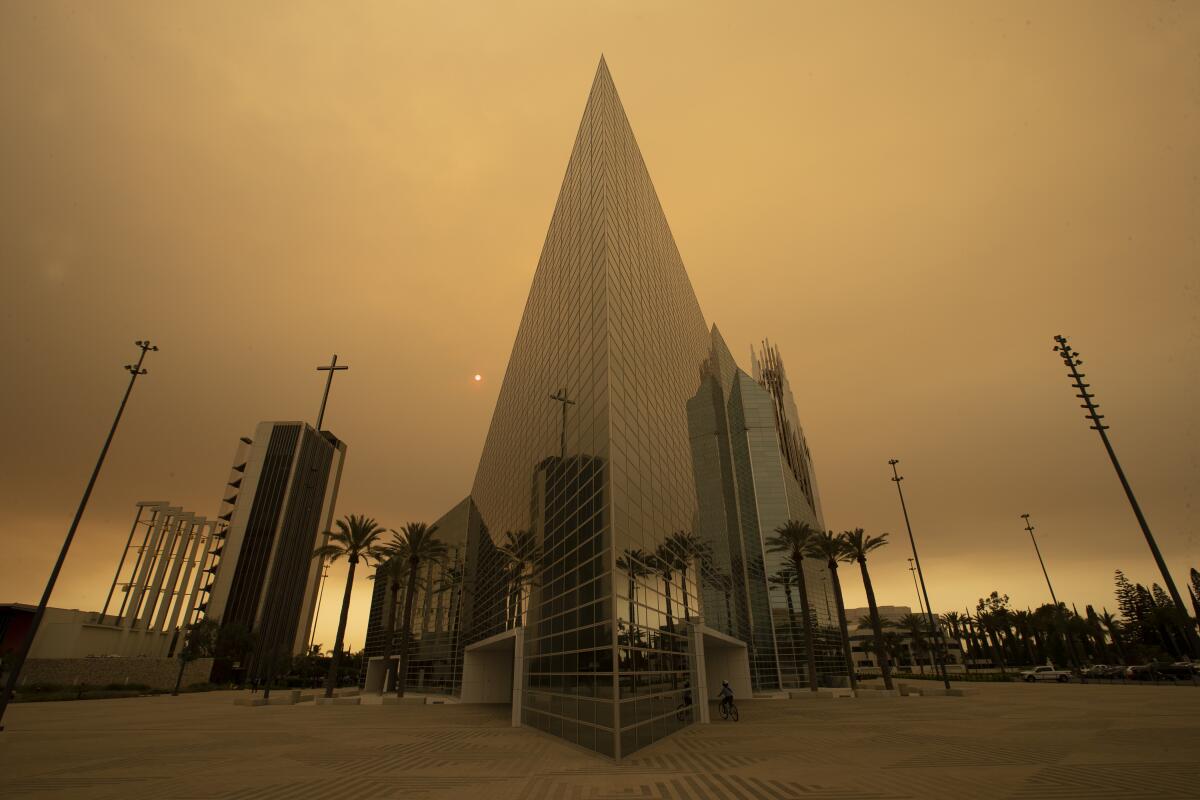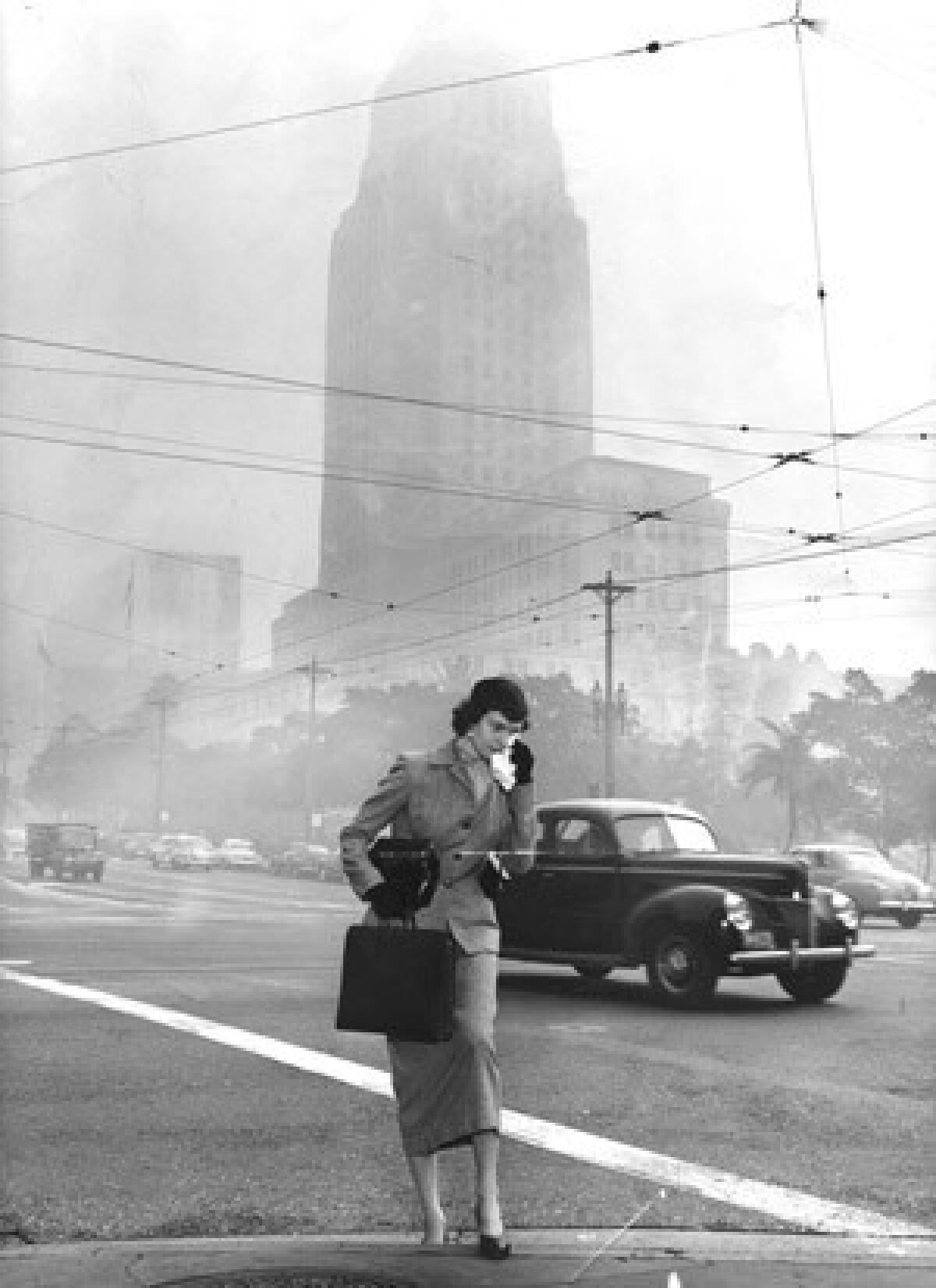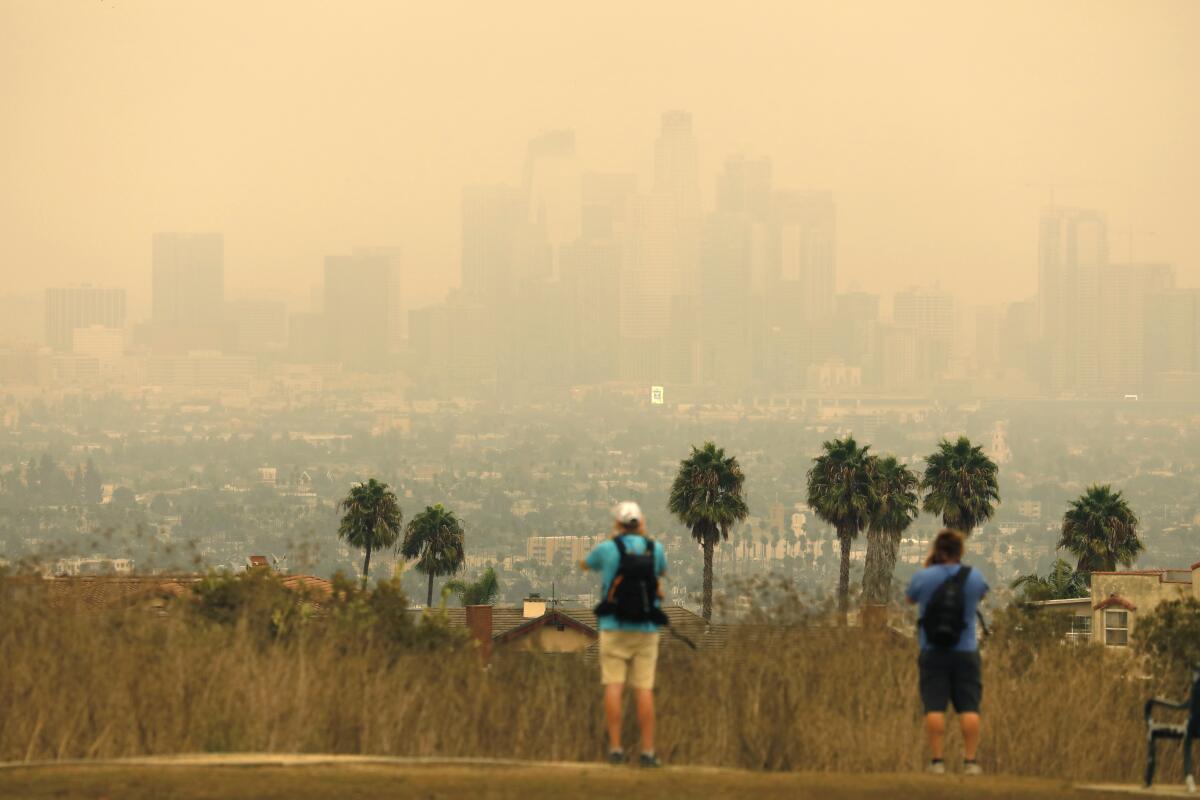Essay: From fires to pollution, smog has been California’s dark companion for centuries

- Share via
When I close my eyes and think about that day in the late 1970s, I’m struck by the colors. The bright red of my favorite shirt. The silvery gray of smog sifting through the trees. The leaves, bleached by chemicals in the air, were soft-edged blobs of an indiscriminate dark hue.
I was in college and I’d driven from Northridge to Pasadena to visit the Norton Simon Museum. I don’t remember the paintings. What I do remember is the air pollution, thick and viscous.
It is hard not to think about smog during this terrible mid-September. California is on fire, millions of acres torched, tens of thousands of people evacuated. The pall of smoke from Northern California’s flames has been visible from space.
The sky is an orangey tan in the San Gabriel Valley, cement gray-brown even at the beach. Mountains have vanished behind the haze. It’s like a memo from Southern California’s past, a dire reminder of the bad old days when smoke-belching cars rolled through the streets, unchastened, when City Hall was regularly obscured and we’d yet to figure out what made our eyes sting and our lungs burn.
The air was so bad this weekend that eight Los Angeles County parks were closed, and “reopening is contingent on air quality and safety measures.”
The smoke forced a handful of county-run coronavirus test sites to close, one assault on our lungs making it harder for us to monitor another.
The Los Angeles Basin has a long, dark relationship with smog. In 1542, explorer Juan Rodriguez Cabrillo christened San Pedro Bay “La Bahia de los Fumos” — the Bay of Smokes — because of the persistent, ground-hugging smoke from fires set by members of the Gabrielino-Tongva tribe as they hunted game on the hillsides.
There have been so many milestones since.
In 1901, a particularly bad-air day was mistaken for an eclipse of the sun.
In July 1943, thick, persistent smog in downtown Los Angeles shrank visibility to just three blocks. That episode kicks off “Smogtown: The Lung-Burning History of Pollution in Los Angeles.” As authors Chip Jacobs and William J. Kelly noted in the 2008 work, “though nobody realized it then, the mystery cloudbank would rattle the planet — making ‘green’ a cause, not just a color — but first there was the suffering, a city full of it.”
And on Sept. 13, 1955, this car-loving sprawl of a city experienced the smoggiest day in its history, one that has not been equaled since. The ozone level in downtown L.A. was a lung-damaging 0.68 parts per million. In contrast, this Labor Day weekend was the worst air day in a generation; the ozone level spiked at just 185 parts per billion.
::
Sunday was the 65th anniversary of that smoggiest day ever, a reminder that, although there is much work to be done to make Southern California’s air more breathable, we still have come a long way.
If you celebrated by looking out the window, however, chances are you saw ... not very far.
On Saturday, Mary Nichols put off taking her dog for a morning walk. She lives in the Mid-Wilshire area, and by late afternoon, she said, it hurt to breathe. We are inhaling everything that burned, and it’s not just trees and brush.
“It’s also houses and commercial buildings and other things that were in [the fires’ path],” she said. “It’s undoubtedly got some unhealthy things in addition to just plain old carbon soot. ... There’s going to be chemicals from burning tires, burning plastics, all of which are more seriously harmful to health.”

Nichols knows her smog and how air quality in the Golden State has improved through the decades. She is chairwoman of the California Air Resources Board, first appointed to the job by then-Gov. Jerry Brown in 1975. She has served in the same position on and off since, under Govs. Arnold Schwarzenegger, Brown again and, now, Gavin Newsom.
Nichols took her first trip to Los Angeles in 1969 when she was a student at Yale Law School. She and classmate arrived in the city in late afternoon.
“I remember descending into the basin, driving west toward Sunset Boulevard and being astonished by the peculiar color of the air,” she told The Times in an early profile. “It was a kind of flaming orange — not a natural color, but a peculiar, day-glo, chemical kind of orange.”
Today, she has other sensory memories of when breathing in Los Angeles was a regular assault on the lungs.
“I have a more vivid memory of the smell of the air, especially around LAX,” she said in an interview Saturday. “There were chemicals in use in those days that are no longer in use. ... You had both the ugly gray sky and the smell of the air.”
Nichols filed what is often described as the first lawsuit under the federal Clean Air Act, suing the state of California to force then-Gov. Ronald Reagan to meet the requirements of the federal Environmental Protection Agency. She won, but found out that making governments change is slow, hard work.
The single biggest step toward improving air quality, she said, was requiring catalytic converters on all new cars. California pushed oil companies to formulate unleaded gasoline for use in the state. The federal government followed later. Another major improvement was requiring power plants to shift from oil to natural gas, she said; they have since become cleaner still.
For all the gains, however, improvements have plateaued in recent years, and pollution levels have begun to creep back up. One thing that worries air pollution attorney Adrian Martinez is that people often measure our progress against the smoggiest days of the 20th century. And that gives a false sense of accomplishment.
“We’re not going back to the levels of the ’60s and ’70s, but if your strategy is to make it safe to breathe, we need dramatic reductions in pollution,” said Martinez, who is a staff attorney with the environmental group Earthjustice and tweets as @LASmogGuy.
That means, he said, “we need to go to zero emissions,” and not just with cars, but also with more serious polluters such as ships and trains. He does, however, see some hope. As a country we’re talking more about environmental justice, about the need to clean the air where poorer people live, too, in neighborhoods crisscrossed by a lattice of freeways coursing with the exhaust of interminable traffic.
There may be an odd upside to our current gray skies.
“If being in the pollution makes us realize how harmful it actually is, it could give us the impetus to solve this air pollution problem,” Martinez said. “Lots of lives will be saved. That’s the big thing. Air pollution is literally a life-or-death issue. ... It’s a shame it took these fires and pandemic, but hopefully we can shift how we operate.”
::

My family moved from central New Jersey to Southern California in February 1969, Cranbury Township to the San Fernando Valley. I was a chubby, lost 9-year-old, a smog-earthquake-wildfire novice.
Growing up in Granada Hills and Northridge, I remember seeing the nearby foothills for the first time on a rare, clear day. They were craggy, beautiful and so close. They’d been hidden behind a mantle of smog. I was stunned.
During my first fire season, I stood on our front lawn on Rinaldi Street, mid afternoon, dark as night. Ash like fat snowflakes sifted down. Evacuees drove by, their cars filled with belongings snatched in panic.
I vowed that, if God spared us, I would enter the convent.
We were fine.
And now, as the worst fire season in California history rages on, I am parked at the western end of Rose Avenue in Venice, a block or so from the scruffy apartment building where I lived in the mid-1980s.
It is Saturday, 8:45 a.m. The ocean is a slender, dark gray stripe, the horizon a mere suggestion. Malibu has disappeared, ditto the Palos Verdes Peninsula. The sun is a hazy, salmon-colored disc. My eyes sting.
Looking east, there is nothing beyond Pacific Avenue.
You need memory to believe the San Gabriel Mountains still rise somewhere in the distance.
And faith to believe you will see them again.
In California, in 2020, the first one is easy.
More to Read
Sign up for Essential California
The most important California stories and recommendations in your inbox every morning.
You may occasionally receive promotional content from the Los Angeles Times.











